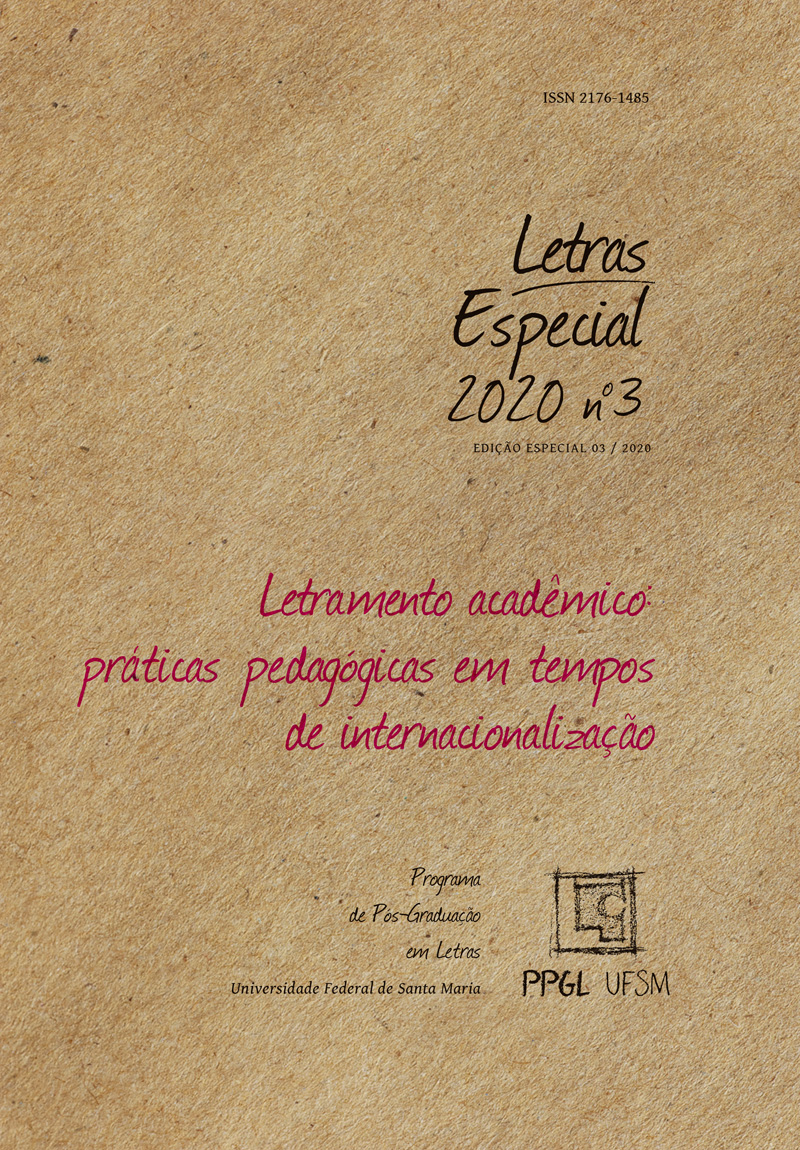Using speaking as a springboard to academic writing: a successful pedagogical experience
DOI :
https://doi.org/10.5902/2176148554628Mots-clés :
EAP, Speaking, Academic writing, Integrated skillsRésumé
English for Academic Purposes (EAP) is at the forefront of "both theory development and innovative practice in teaching English as a second/other language" Hyland (2006, p.1), as it has become the predominant language in science and research. However, many EAP courses still lack a theoretical rationale, and teachers rely on textbooks or teaching experiences to develop their own methodology and material. Based on Newton (2018), Kroll & Vann (1981) and Weissberg (2006), this contribution reports on a successful pedagogical experience that connected the use of speaking to foster the development of academic writing of EAP students in a Brazilian university.
Téléchargements
Références
CELCE-MURCIA, M.; OLSHTAIN. E. Teaching language through dis-course. In: CELCE-MURCIA, M.; BRINTON, D.; SNOW, M. A. (Eds.). Teaching English as a second or foreign language, 4. Ed. Boston: Heinle Cengage Learning, 2014, p. 471-487.
CHAZAL, E. English for academic purposes. United Kingdom: Oxford University Press, 2014.
DUTRA, D. P. et al. Institutional internationalisation through aca-demic literacies in English: teaching and learning written genres in the Brazilian higher education context. The Especialist, [S.l.], v. 40, n. 2, p. 1-14, 2019. DOI: https://doi.org/10.23925/2318-7115.2019v40i2a5
DEARDEN, J. English as a medium of instruction – a growing global phenomenon. London: British Council. 2015. Retrieved from: https://www.britishcouncil.org/sites/default/files/e484_emi_cover_option_3_fi-nal_web.pdf. Accessed on: July 27, 2020.
GEORGE BROWN COLLEGE. Hooks and Attention Grabbers. Tutoring and Learning Centre, George Brown College, 2014. Available at: https://www.georgebrown.ca/sites/default/files/uploadedfiles/tlc/_docu-ments/hooks_and_attentin_grabbers.pdf. Accessed on: March 18, 2020.
HU, G.; LIU, Y. Three-minute thesis presentations as an academic genre: a cross-disciplinary study of genre moves. Journal of English for Academic Purposes, v. 35, p. 16-30, 2018. DOI: https://doi.org/10.1016/j.jeap.2018.06.004
HUDZIK, J. Comprehensive internationalization: from concept to action. Washington: NAFSA, 2011.
HYLAND, K. Second language writing. Cambridge: Cambridge University Press, 2003. DOI: https://doi.org/10.1017/CBO9780511667251
HYLAND, K. English for Academic Purposes. Routledge Applied Linguistics, 2006. DOI: https://doi.org/10.4324/9780203006603
HYLAND, K. Genre pedagogy: language, literacy and L2 writing instruc-tion. Journal of Second Language Writing, v. 16, n. 3, p. 148-164, 2007. DOI: https://doi.org/10.1016/j.jslw.2007.07.005
JOHNS, A. M. Genre awareness for the novice academic student: an ongoing quest. Language Teaching, v. 41, n. 2, p. 237-252, 2008. DOI: https://doi.org/10.1017/S0261444807004892
JOHNS, A. M.; PRICE D. English for specific purposes: International in scope, specific in purpose. In: CELCE-MURCIA, M.; BRINTON, D.; SNOW, M. A. (Eds.). Teaching English as a second or foreign language, 4. ed. Boston: Heinle Cengage Learning, 2014, p. 471-487.
JORDAN, R. R. The growth of EAP in Britain. Journal of English for Academic Purposes. v. 1, p. 69-78, 2002. DOI: https://doi.org/10.1016/S1475-1585(02)00004-8
KNIGHT, J. Internationalization remodeled: definition, approaches, and rationales. Journal of Studies in International Education,8(1), 2004, p. 5-31. DOI: https://doi.org/10.1177/1028315303260832
KNIGHT, J. Higher education in turmoil: The changing world of internationalization. Rotterdam: Sense Publishers. 2008. DOI: https://doi.org/10.1163/9789087905224
KROLL, B. M.; VANN, J. R. Exploring speaking-writing relationships: connections and contrasts. Urbana, Ill: National Council of Teachers of English, 1981.
NEWTON, J. M. Speaking in a second language. In: NEWTON, J. M.; FERRIS, C. C.; GOH, M.; GRABE, W.; STOLLER, F. L.; VANDERGRIFT, L. (Eds.). Teaching English to second language learners in academic contexts: reading, writing, listening and speaking. New York: Routledge, 2018, p.185-200. DOI: https://doi.org/10.4324/9781315626949-15
NEWTON, J. M.; FERRIS, C. C.; GOH, M.; GRABE, W.; STOLLER, F. L.; VANDERGRIFT, L. Teaching English to second language learners in academic contexts: reading, writing, listening and speaking. New York: Routledge, 2018. DOI: https://doi.org/10.4324/9781315626949
PALTRIDGE, B. Genre and the language learning classroom. Ann Arbor, MI: University of Michigan Press, 2001. DOI: https://doi.org/10.3998/mpub.23749
PAYNE, D. Integrating Oral and Written Business Communication. In: KROLL, B. M.; VANN, R. J. Exploring speaking-writing rela-tionships: connections and contrasts. Urbana, Ill: National Council of Teachers of English, 1981, p. 184-197.
SNOW, A. M. Content-based and immersion models of second/foreign language teaching. In: CELCE-MURCIA, M.; BRINTON, D.; SNOW, M. A. (Eds.). Teaching English as a second or foreign language, 4. ed. Boston: Heinle Cengage Learning, 2014, p. 471-487.
SWALES, J. M. Genre analysis: English in academic and research settings. Cambridge: Cambridge University Press, 1990.
WEISSBERG, R. Connecting speaking & writing in second language writing instruction. Ann Arbor: University of Michigan Press. 2006. DOI: https://doi.org/10.3998/mpub.6702
Téléchargements
Publié-e
Versions
- 2022-07-26 (6)
- 2022-07-11 (5)
- 2022-07-11 (4)
- 2022-07-11 (3)
- 2022-07-11 (2)
- 2021-10-19 (1)
Comment citer
Numéro
Rubrique
Licence
(c) Tous droits réservés Letras 2021

Cette œuvre est sous licence Creative Commons Attribution - Pas d'Utilisation Commerciale - Partage dans les Mêmes Conditions 4.0 International.
Ficam concedidos a Letras todos os direitos autorais referentes aos trabalhos publicados. Os originais não devem ter sido publicados ou submetidos simultaneamente a outro periódico e não serão devolvidos. Em virtude de aparecerem nesta revista de acesso público, os artigos são de uso gratuito, com atribuições próprias, em aplicações educacionais e não comerciais.






